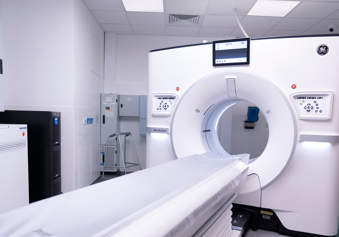

Portfolio Pathway (formerly CESR) (Radiology)
Getting Started
Specialty Specific Guidance (SSG)
The standard for a Portfolio Pathway (formerly CESR) in the CCT specialty of clinical radiology focuses on the Knowledge, Skills and Experience (KSE) needed for practising as an eligible specialist in the United Kingdom.
Doctors must be registered on the GMC’s Specialist Register to take up a substantive (permanent), fixed-term or honorary NHS consultant post. If you haven't completed training in the UK or don't have an acceptable EEA or Swiss qualification, you can make an application on the Portfolio pathway (formerly known as CESR) to obtain specialist registration. To be eligible to apply via this route, you must have either a specialist qualification or at least six months of continuous specialist training in the specialty you’re applying in.
To find out more about these KSEs, you should consult the latest Specialty Specific Guidance (SSG), which describes what you should be able to demonstrate as well as the evidence you will need to provide. Reading and following this guidance carefully will help you to strengthen your application and, while you compile your evidence bundle, you can use it as a checklist to make sure you’ve included all the evidence that’s needed.
Support from the College
We are happy to help you with your Portfolio queries by email. These should be sent to [email protected]. In providing you with advice and guidance in respect of your Portfolio Pathway application, we cannot give guarantees or opinions as to the likelihood of your application being successful, nor can any such advice guarantee success in any application. Please include a copy of your CV where possible. The GMC's CESR CV advice and this article from the BMJ about preparing a medical CV can help you to structure this.
As well as the guidance on this page, we also offer a drop-in clinic for Portfolio questions every six weeks and live webinar sessions. Please see the College Events calendar for more information.



Stage 1.
Make your application
You need to make your Portfolio Pathway application to the GMC, using the dedicated online application process. Open a GMC Online account and upload all your evidence electronically, as requested in the online application. Anything recorded in Kaizen or in any other ePortfolio won't be transferred into a Portfolio Pathway application.
Step 2.
Application sent to us
The GMC will send your completed application to us for specialist evaluation. We make a recommendation to the GMC as to whether the application should be approved, but the GMC makes the final decision.
Step 3.
The decision
Once we have reviewed the application and submitted our evaluation to the GMC, they then spend some time reaching a final decision.
In total, the process can take around 2-3 months before you are informed of the final decision.
How to apply
You need to make your Portfolio Pathway application to the GMC, using the dedicated online application process. Open a GMC Online account and upload all your evidence electronically, as requested in the online application. Anything recorded in Kaizen or in any other ePortfolio won't be transferred into a Portfolio Pathway application.
The GMC will send your completed application to us for specialist evaluation. We make a recommendation to the GMC as to whether the application should be approved, but the GMC makes the final decision.
We are happy to assist with queries by email about our specialty-specific guidance, just send a copy of your CV. Think about structuring your CV in accordance with the GMC's Portfolio Pathway CV advice, and use this article from the BMJ about preparing a medical CV.
The application form, fees, guidance, criteria and general process are subject to change. Refer to the GMC’s website for questions and updates.
This is the most appropriate route for most applicants and most people apply for a Portfolio Pathway in clinical radiology.
In the UK, Clinical radiology trainees complete about five years of specialty training according to the current training curriculum. When they successfully complete training they are awarded a Certificate of Completion of Training (CCT) in the specialty of Clinical radiology. The CCT allows them entry to the GMC specialist register.
To be awarded this Portfolio Pathway, you need to submit a range of evidence to demonstrate that your specialty training, qualifications and experience taken together are equivalent to the CCT in clinical radiology, as set out in our specialty training curriculum. A Portfolio Pathway allows you entry to the GMC specialist register.
To be eligible to apply under this route, you must have either a specialist qualification in the specialty you apply in or at least six months of continuous specialist training in the specialty you apply in.
Please review the following documents:
-
The Specialty Specific Guidance published by the GMC to help you make your application. When getting your evidence together, you can use it as a checklist to make sure you include all the documents we need.
-
Our FAQs for Portfolio Pathway Applicants which sets out things to note when making your Portfolio Pathway application.
Some doctors may be eligible to apply for a Portfolio Pathway in a non-CCT specialty, which if successful leads to specialist registration in that specialty. A non-CCT specialty is a narrower medical specialty than “Clinical radiology”; (for example, breast radiology, neuroradiology, paediatric radiology, interventional radiology and so on). It must be a specialty consistent with NHS consultant practice.
To be eligible to apply, you must have either a specialist medical qualification from outside the UK in any non-CCT specialty, or at least six months of continuous specialist training outside the UK in any non-CCT specialty.
Your application must demonstrate that your qualification and/or training, along with your subsequent experience, gives a level of knowledge and skill consistent with practice as an NHS consultant.
Please consider very carefully whether you are eligible to apply - just working in one area of expertise will not necessarily mean that you are eligible to apply for a non-CCT Portfolio Pathway.
You must have completed a dedicated period of training outside the UK (such as a Fellowship; rotations in your general radiology training are unlikely to count) or obtained an overseas specialist qualification in a non-CCT specialty. A successful applicant is likely to be practising independently in their field at NHS consultant level, so please consider any potential differences in your practice and what is expected of an NHS consultant in the UK.
Specialist registration in a narrow area may limit your employment options and you should check whether you are likely to obtain employment in that area. You must check with the GMC as to your eligibility and whether the specialty in which you intend to apply is acceptable. You can also contact the RCR for advice by email by attaching a copy of your CV.
NHS consultant practice includes all the areas set out in the CCT curriculum, so we expect that a non-CCT Portfolio Pathway application will reflect the 12 CiPs in the curriculum. Please see the links to our advice and guidance below, including the Specialty Specific Guidance. The main difference is that the clinical elements of your evidence (such as the radiology reports you must submit) are likely to cover the specialty areas of the CCT curriculum (2021) relevant to that non-CCT specialty, rather than across the breadth of the curriculum.
A non-CCT Portfolio Pathway application is evaluated against the four Domains of Good medical practice. Otherwise, the application process is the same as for the Portfolio Pathway in a CCT specialty.
Each CiP in the SSG has a range of suggested evidence to support it. If you apply for a Portfolio Pathway in a non-CCT specialty, make sure that you submit a good range of evidence by referring to what the SSG asks for in each CiP to support each Domain as follows:
- Domain 1 – see CiPs 2, 5, 7, 8, 9, 10, 11. If you apply for a non-CCT Portfolio Pathway in Interventional radiology, you also need to see CiPs 13 and 14 and requirements in the Interventional radiology subspecialty curriculum (2021)
- Domain 2 – see CiPs 3 and 4
- Domain 3 – see CiPs 1, 6 and 12
- Domain 4 – see CiP 1
This route is designed for those who are nationally renowned leaders, known internationally in their field through their academic or research activity.
Applicants must show that the knowledge and skills they have gained through academic or research work are consistent with practice as a consultant in any of the UK health services. Successful applications tend to be submitted in very specific areas because it is difficult to demonstrate academic or research work in a broad area such as a CCT specialty.
Your application needs to show two things:
- That your academic or research work has given you knowledge and skills to the standard of an NHS consultant.
- That your clinical knowledge, skills, and experience of the specialty you have applied in are equivalent to the standards of an NHS consultant.
The range of evidence requested here is different from the other Portfolio Pathway pathways, as you can see in the GMC academic Portfolio Pathway guidance. You will have to provide evidence of your academic or research activities, as well as evidence of your clinical skills in the area in which you apply - the clinical elements are likely to cover the relevant specialty areas of the CCT curriculum. You must check with the GMC as to your eligibility and whether the specialty you intend to apply in is acceptable under this route.
Please see the GMC's information for doctors about Brexit.
If you have an EEA or Swiss primary and/or specialist medical qualification classed as a "relevant European qualification", you may be able to apply for GMC full and/or specialist registration using those qualifications. It is the qualification you hold and not your nationality that determines whether you can use these qualifications to obtain registration.
FAQs for Portfolio Pathway applicants
Your application is made directly to the GMC using their dedicated online application process. Please see the GMC website for further information on how to apply.
You compile your Portfolio Pathway application in liaison with the GMC. Once the application is deemed complete by the GMC, it is passed to the College for assessment. Applications are evaluated by the RCR Equivalence Committee and a recommendation is then made to the GMC.
To be eligible to apply you must have either a specialist qualification in the specialty you apply in or at least six months of continuous specialist training in the specialty you apply in.
Information can be found in both the Specialty Specific Guidance and generic guidance available on the GMC website. You should read this guidance carefully because it defines the type of evidence you should provide to demonstrate their knowledge, skills and experience (KSE) for specialist practice in the UK.
No. As the RCR officially reviews the applications, we only review them at the point they are submitted to us by the GMC. The RCR can provide advice on the type of evidence required but will not review your application before submission. You are encouraged to read the Specialty Specific Guidance carefully before submitting your application to the GMC.
It is recommended that you collect and keep evidence as you go along. You will need to open a GMC Online account and upload all your evidence electronically, as requested in the online application.
The RCR Equivalence Committee reviews applications on behalf of the GMC. Members of the Committee will determine whether you have the knowledge, skills and experience needed for practising as a day one consultant in the UK. If your application is successful, you will be recommended for entry to the Specialist Register.
Before sending the complete application to the RCR for evaluation, the GMC first needs to ensure that all the application documentation has been received, including the structured reports from referees, and complete the verification process. This part of the process can be lengthy, as the GMC may need to ask for further information.
When the application is passed to the RCR we have 36 working days to review and submit our evaluation to the GMC.
The GMC will then need time to reach their final decision, so in total you should expect it to take 2-3 months before you are informed of the outcome of the evaluation.
You will receive a report directly from the GMC that will explain why your application has not been successful. This will contain recommendations outlining the additional evidence required.
A non-CCT specialty is a narrower medical specialty than “Clinical radiology”, for example, breast radiology, neuroradiology, paediatric radiology, interventional radiology and so on. It must be a specialty consistent with NHS consultant practice.
To be eligible to apply, you must have either a specialist medical qualification from outside the UK in any non-CCT specialty, or at least six months of continuous specialist training outside the UK in any non-CCT specialty.
You should read the Specialty Specific Guidance carefully as this defines the type of evidence that you should provide to demonstrate you have the knowledge, skills and experience required to practise as a specialist or GP in the UK. You should also review the relevant curriculum.
Providing Evidence
What are the evaluators looking for? How should I present my evidence? What if I can’t provide a particular piece of evidence? What does that term mean and does it matter if my workplace calls it something else? This guide will answer some of the questions we’re most often asked by email or at our regular drop-in clinics but don’t worry if you can’t find the solution here – just email us at [email protected] and we’ll be happy to help.
The FRCR is the test of knowledge set out in the CCT curriculum. Applicants who do not have the FRCR must submit evidence relating to all specialist qualifications held. The standards for the award of the FRCR are set out in the syllabus for the First and Final Examinations. If you don’t hold the FRCR, you must submit as much evidence as possible regarding your training to demonstrate that you have the same knowledge, skills and experience and that you have been assessed in your specialty. Such evidence might include emergency radiology in the acute setting, cross-sectional and fluoroscopic imaging, participation in MDT meetings with case histories and notes and assessment of these skills and competencies and regular assessment during training. You should provide the curriculum or syllabus that was in place when you undertook your training.
In addition, the Specialty Specific Guidance (SSG) will detail where extra evidence is required under the relevant CiP if you don’t hold the FRCR.
If you have failed any part of a qualification, you should consider delaying your application until you have passed the failed element. Otherwise, you will need to consider very carefully whether and how you can demonstrate that you have since met the competency requirements of that examination, even if you have subsequently passed a different examination. The RCR will check details of any RCR examinations you have taken, including any part in which there is an outstanding failure.
You can provide an index page at the beginning of each CiP to detail what you’ve included and to cross-reference evidence that you’ve included under other CiPs – you don’t have to duplicate evidence if it’s relevant in more than one area. For example, you need to include MDT activity in CiP 12 but can cross-reference it in an index list under CiP 6.
This may be especially helpful when providing your sample reports. Separating them into separate sections for each system makes your bundle much easier to navigate. Annex A of the SSG has further information about how you should provide these as well as an example of a summary list.
You should submit your most recent appraisal – this should be from the last year of your clinical practice prior to application. You should also provide evidence of formal appraisal/review over the last three years of your clinical practice. Your appraisals do not all have to be from the same post, but all should be from within the last three years. Your appraisal should contain reflection on your performance over the year and include a personal development plan (PDP) of goals or objectives to be met in the coming year.
We will not be able to see any attachments to your appraisals (such as your CPD record), so you will need to ensure these are provided where required.
If your employer doesn’t undertake annual formal appraisal, you must provide other similar evidence of review, which must include a discussion of your clinical practice, teaching and training, managerial and administrative activity.
If areas for development were highlighted (for example in your MSF), please provide evidence to demonstrate that these have been addressed, with certificates for any courses you’ve done plus reflection on the changes you’ve made.
Appraisals/assessments completed retrospectively will not be given as much weight as one that was completed at the relevant time.
Clinical audit is designed to improve quality of care and healthcare outcomes by comparison against agreed standards and measuring the success of interventions. Quality Improvement Projects are designed to improve quality of care and healthcare outcomes by trialling interventions, using repeated measures to assess success.
Applicants are required to show how they have instigated, collated and presented a piece of work, as well as how they have reflected on any changes in clinical management as a result of the work completed. You should also show evidence of presenting the results, such as at appropriate meetings (for example, appraisal, REALM or clinical governance meetings), and how their messages were made known to the wider department, for example via posters, new/revised protocols or new/revised standard operating procedures (SOPs).
Completion of clinical audit and/or quality improvement projects is a specific curriculum requirement. You should submit 1-3 clinical audits or quality improvement projects. At least one of them should show completion of the audit cycle (“closing the loop”) either through re-audit or evidence of the implementation of change through quality improvement projects. Make sure you clearly show how and whether improvements or changes have been made.
The strongest evidence is the report and action plan, any re-audit or changes in practice and a presentation. Reflection on audit and quality improvement activity is required and workplace-based assessments on projects can also be useful.
The audit and quality improvement pages on the RCR website include the “AuditLive” section, which is a collection of templates identifying best practice in key stages of the audit cycle.
Letters stating that you have participated in these activities are useful background, but will not be sufficient evidence on their own.
You should submit a range of letters and emails to and from referring clinicians; you can also include patient consent forms and other correspondence you consider relevant. You should provide a range of clinical correspondence with colleagues showing that you can communicate effectively in respect of the clinical questions arising, for example on reviewing images, discussion of findings, offering advice on appropriate imaging, vetting and protocol issues, communicating pertinent findings, consent, asking for a second opinion, on image quality, and arranging IR procedures.
Evidence of your clinical correspondence can support a number of CiPs, including those relating to communication, patient management and clinical competence. For example, you can include evidence relating to correspondence with radiographers or the PACS team alerting them on issues such as missing images, incorrect markers, inadequate coverage, recalls and similar safety and quality issues and correspondence relating to emergency or on-call findings. Please refer to the CiP descriptors for more specific information as to what your correspondence should demonstrate.
Vetting and protocolling evidence can be provided as emails or screenshots of the system used by your institution. Correspondence discussing more appropriate imaging or why the request hasn’t been accepted is helpful here.
You can subdivide within the file as set out in the SSG. For example, clearly indicate that correspondence relates to safety and quality, emergency and on-call findings and so on.
You should submit minutes of relevant meetings or other relevant activity in which you have participated – for example:
- clinical governance meetings
- discrepancy or Radiology Events and Learning meetings (REALMs)
- radiology department meetings
- morbidity and mortality (M&M) meetings
Invitations to meetings or agendas for meetings will be given less weight without the minutes, outcome or confirmation of your attendance.
Candidates often worry whether their application will be turned down if they provide examples of actual complaints. However, we know that incidents do happen and complaints are made. Complaints should no longer be hypothetical. What we are interested in is:
- your understanding of the framework for handling adverse events where you work
- how you deal with or respond to these events
- what these show about your own insight and professional judgement
- what you have learnt through dealing with these issues
Evidence relating to 1-3 examples from the last three years of your clinical practice should be sufficient.
Complaints can be received against you, but it is also acceptable to include complaints about the department you worked in or against a colleague where you were involved in the resolution. You can provide evidence of your response to any complaint or untoward incident. If you have raised a concern, you could provide relevant evidence of that. Complaints can be formal or informal.
Please be sure to provide evidence of how the situation was resolved, and reflection or any CPD that resulted.
Evidence of participation in courses and learning events relevant to the curriculum is useful supporting evidence in respect of a number of CiPs, particularly in respect of:
- clinical courses to show you are making efforts to maintain good practice, including in AI and new technological developments
- courses relevant to equality and diversity, consent, data protection/information governance, equality, diversity and human rights, ethics, probity and so on
- courses relevant to maintaining knowledge and skills in procedural activity, such as infection prevention, life support/resuscitation, radiation protection and so on
- teaching
- research
- management and leadership
- communication
CPD activity and courses are given less weight if they were completed more than five years ago, so please make sure that you demonstrate such activity from within the last five years. For each course or conference, you should provide a certificate or similar confirmation of participation.
Please group these together and upload them from the last five years as one file in CiP 3. It would be helpful to subdivide into sections within the file – for example, you might have separate sections for mandatory trust training, clinical courses, teaching-related courses and leadership and management courses.
Annex A of the SSG provides comprehensive details of how you should present your reports and in what order. Reports can be from more than one role within the last five years of your practice and must be identifiable as being from the institution where they occurred – copied text in isolation will not be considered without certificated authenticity; the reports’ origins must match your CV.
We do not specify a number of reports to be provided but your reporting output evidence should demonstrate that you have a range of radiological experience, across the spectrum of acute and routine work. The minimum is 60 reports, but you can submit more to ensure that the breadth of areas are covered. It is not usually necessary to submit more than 150 reports.
If there is an area in which you cannot submit evidence of performing the relevant imaging procedure, you must submit evidence to show that you have appropriate knowledge of its role, indications, contra-indications and limitations and that you can advise on how and when to refer for these procedures (for example through discussions at MDTs, your clinical correspondence, your reflective activity).
The reporting should be your personally generated, independent reporting activity. A significant amount of reporting completed under supervision or which you have signed off as a supervisor is unlikely to be given as much weight as your personal reporting activity. If it is not clear what your role in generating the report was (for example, primary reporter, secondary reporter, responsible for carrying out a procedure rather than observing it), this will not be considered helpful evidence.
If you do not generally perform interventional procedures, you can submit evidence that you have recent knowledge of IR strategies when investigating common presentations and conditions – for example, by recommending relevant investigations in your reporting and in the emergency setting, by arranging procedures as appropriate or discussing them in clinical correspondence and at MDT.
Evidence of relevant activity – for example:
- rota management,
- responsibility for finances/budgets
- assessments on others, such as workplace-based assessments (these are particularly useful)
- relevant courses and qualifications
- leading MDTs (required for CiP 12)
- chairing other meetings
- acting as audit lead
- setting up new services/service mapping, participation in wider trust consultations, protocol or pathway development, or where you helped to address a service problem or new demand, evidence of course organisation and so on
MDT meeting-related activity may be referred to outside the UK as grand rounds, tumour boards, etc. It may also be called multidisciplinary meetings or MDMs.
You should submit evidence of your activity, such as logbooks or a rota of MDT attendance. This evidence should include:
- your attendance and exact role
- dates or frequency of meetings
- examples of numbers and type of imaging relevant detail, including outcome decisions
You should also include reflective activity on MDTs, especially on your personal contribution. We need to see not only that you are a core member of one or more MDT meetings, but also primary evidence of your leading the discussions.
An assessment of your performance at MDTs should also be submitted – for example, in your structured reports, by way of a letter or assessment from the MDT lead or person in a similar capacity or by MDTA workplace-based assessment.
In the absence of formal MDT or tumor board setting, clinical correspondence discussing radiological reports must be provided, showing specific multidisciplinary patient care.
This is a method used to assess common skills, including behaviours, team working and communication skills. It is sometimes called 360-degree feedback.
You should supply evidence of feedback from colleagues of all levels (senior doctors and consultants, doctors in training, radiographers, nurses/allied health professionals, clerks, secretaries and auxiliary staff), preferably as part of a structured, unselected MSF package completed at the relevant time. This evidence must be as recent as possible and at least within the last five years of practice. The MSF must be conducted anonymously. One round of formal MSF is the minimum you should submit.
Structured, unselected patient feedback is the best evidence to submit to demonstrate good patient relationships and communication but you can also provide other objective evidence that demonstrates effective communication with patients and obtaining consent where necessary; for example, patient feedback forms, workplace-based assessments, appraisals.
Personal reflection on this MSF and self-assessment are also useful.
Letters, references for posts applied for and so on are useful, but may not be given as much weight as structured, unselected MSF. Invited testimonials, personal greetings or thank-you notes from patients are also less relevant here.
MSF may not be offered in all workplaces. If you do not have any MSF available, please provide the following instead:
- Anonymised colleague feedback
- Personal reflection on, and your contribution to, collaborative working. This must include:
- 6–10 examples of work output, including rotas/timetables
- coverage of all specialties, with clarity on how you use radiology reports to enable clinical colleagues to handle or manage patients, and comments on image quality and studies.
You can submit a range of these as objective confirmation that you are participating in on-call activity and of your other timetabled activity. It is usually sufficient to provide 2–3 months of these from your recent employment. It must be clear what any rota activity involved, such as elective, emergency, adult, paediatric, procedural, cross-sectional or fluoroscopy. Organisation-specific but unclear terminology (e.g. “reporting on 5th floor”) must be explained to allow assessors to know what this involved.
This is extremely important to your application. Throughout the evidence listed, reflective practice is requested. Reflecting on your experience is important to your development as a doctor and in improving the quality of patient care. Your evidence should demonstrate reflective activity as a regular feature of your practice, not all completed on one day.
You should submit a range of your reflective activity on areas such as CPD, learning events, teaching, research, audit and quality improvement activity, discrepancies, complaints and significant events, appraisal, MSF and MDT activity.
We want to see specific examples of your own experiences and how a particular situation has impacted you and what you have learnt, such as
- how the activity contributed to the development of your knowledge, skills or professional behaviours
- ways in which your own behaviour may change as a result of reflecting on the event
- what difference this will make to patient safety and quality
If you are unfamiliar with reflective practice, you should read the GMC guidance on reflection to help you understand the principles behind it and how to demonstrate it. You may find it helpful to use the RCR’s reflection template to help with structuring your activity. A reflective template has been incorporated into the RCR’s CPD online journal to help you create your reflective activity each time you undertake CPD. This can also be followed for all your activity. Additional resources can be found on the CPD section of the RCR website.
Your reflection can be included in the file next to the item on which you have reflected – for example, CPD, clinical governance, audit/QI and so on – or can be grouped together in CiP 2.
You should provide evidence of your ability to engage in evidence-based practice. This can include such things as:
- publications
- posters
- abstracts
- literature reviews and/or examples of how you have identified and appraised literature to inform practice such as correspondence with colleagues
- clinical correspondence that refers to relevant activity
- applications for research projects
- ethics committee participation
- patient consent forms
- Good Clinical Practice (GCP) certificate (including an Introduction to GCP course or a CGP Refresher course) and or other relevant course or qualification, such as duty of candour, AI and other activity relating to emerging technologies, research/ethics courses or qualifications
Publications available in the public domain can be uploaded into one file as they do not need to be verified.
For example:
- clinical governance activity
- participation in a review of patient leaflets
- development of standard operating procedures and protocols
- participation in clinical trials
- relevant publications
- evidence of presentations at audit meetings
- reflective activity
- CPD related to safety and quality
Letters stating that you have participated in these activities are useful supporting evidence but are insufficient evidence on their own. Much of your evidence may be included under other CiPs but anything that has not can be uploaded into one file per institution here.
You should provide evidence of acting as a clinical teacher or supervisor – for example:
- formal learner feedback – this is extremely important; it is the impact of your teaching activity that is being evaluated here, not just what you say by way of your presentation content.
- example presentations (PowerPoint etc). Two of these are usually sufficient for this CiP. You can submit two more if you feel they are particularly clinically or otherwise relevant to other CiPs.
- confirmation that you delivered these by way of invitations, correspondence, timetables etc. or other evidence to show how teaching is delivered
You can also include:
- relevant courses or qualifications in teaching
- formal workplace-based assessments of your teaching
Please ensure that your evidence is consistent and triangulates together – for example, if you provide a PowerPoint presentation, that it is consistent with any timetable, correspondence or invitation if you’re submitting those, and that you submit learner feedback relevant to that presentation.
This is required to demonstrate the breadth and depth of your recent radiology-specific practice. This can be from the relevant department’s radiology information system (RIS) to show your range of practice, particularly over at least the last five years. This should also support the range of reporting that you submit.
This evidence can be modality based, but please make sure the examination types (for example, Cardiac CT, CTPA, MRI Liver, etc.) are clear in the totality of your evidence, as well as which examinations were performed in the paediatric population. A breakdown of total number of each type of examination reported/procedures undertaken should be summarised in a table.
If you maintained a logbook for any post during the last five years, you can submit that.
Even if you have been working recently in a limited special-interest area, the evaluators need to be satisfied that, within the last five years, you can demonstrate competence in all modalities, body systems and basic image-guided procedures. Limited general ultrasound workload and limited cross-sectional non-neurological studies (body CT and MRI and musculoskeletal studies, for example) are among the most common reasons for unsuccessful applications. Special interest/subspecialty level is not required in all complex modalities, but limited evidence of activity and low workload numbers (particularly in common and acute general radiology) may reduce your chance of success.
CCT trainees complete a range of assessments in the workplace regularly in each year of their training (see section 4.5.3 of the curriculum for what these are).
We understand that training outside the NHS will not feature these assessments in the same way. For those who have finished training and are working in non-training jobs, you will not necessarily undergo similar assessment in your current job.
WpBAs are not generally expected for clinical activity you have undertaken recently, which is confirmed by your radiology reports and other evidence. However, assessments such as Rad-DOPs and Mini-IPX can be useful if they support a particular range of procedures (such as intervention), a period of additional training you have had, or a clinical activity you do less regularly.
Assessments of your MDT activity (MDTA), teaching (TO) and audit and quality improvement (QIPAT) activity might be useful. Evidence of appraisal/assessment completed retrospectively will not be given as much weight as one that was completed at the relevant time.
If you have completed training within the last five years, you should submit evidence of how you were assessed during your training.
Structured, unselected multisource feedback and patient feedback is the most effective way to evidence your communication and teamworking skills.
Hints and tips for Portfolio Pathway applicants in clinical radiology: advice from assessors to help you succeed
- Know the UK CCT Curriculum: Your application must demonstrate you have the same knowledge, skills and experience as a day one consultant radiologist. Use the RCR's Specialty Specific Guidance (SSG) to structure your evidence.
- Focus on competence: Show you can perform independently in a hospital) setting. A balanced portfolio with general radiology and subspecialty work is key.
- Be recent: Evidence should come from the last 5 years. Older evidence may not hold as much weight.
- Be clear and concise: Triangulate your evidence to ensure consistency across sections (e.g. audit logs, appraisals and teaching records). Avoid repetition.
- Verify your claims: Ensure all information is supported by specify details such as dates, roles and outcomes.
- Include all modalities: Demonstrate experience across general and subspecialty areas (e.g. plain film, CT, MRI, ultrasound).
- Address gaps: Explain any gaps in work history with evidence and a clear rationale.
- Appraisals Matter: Space appraisals appropriately (e.g. two over two years) and include meaningful reflections.
- Use the SSG as a checklist: Map your evidence directly to curriculum domains. Highlight how your experience matches required competencies.
- Structure your documents: Use numbered and indexed files for easy navigation. A clear and logical layout will help assessors understand your submission.
- Sample reports: Provide reports that reflect a range of modalities and complexities, include paediatric and interventional cases.
- Audit and teaching: Back claims with evidence (e.g. audits should include dates, outcomes and your role).
- Balanced portfolio: Avoid over specialisation - highlight the breath of your clinical work.
- Disorganised evidence: Poorly indexed or repetitive submissions slow down assessment.
- Unverified claims: Vague statements (e.g. "I performed teaching!) without outcomes or feedback lack impact.
- Narrow focus: A super specialised portfolio won't demonstrate general radiology competency.
- Ask for advice: Reach out to colleagues who have completed CESR or mentors in your field for guidance.
- Engage with RCR resources: Use templates, checklists and guidance documents provided by the RR to ensure your submission meets standards.
- Plan ahead: The Portfolio Pathway process can be lengthy. Invest time in gathering organising and reviewing evidence.
- Be proactive: Clarify uncertainties with the Workforce Development and Training team or RCR guidance before submitting your applications.
Resources

Clinical radiology
We’re here to support you throughout your career in clinical radiology – offering innovative training and promoting the specialty so that you have the resources you need to deliver better patient care.

